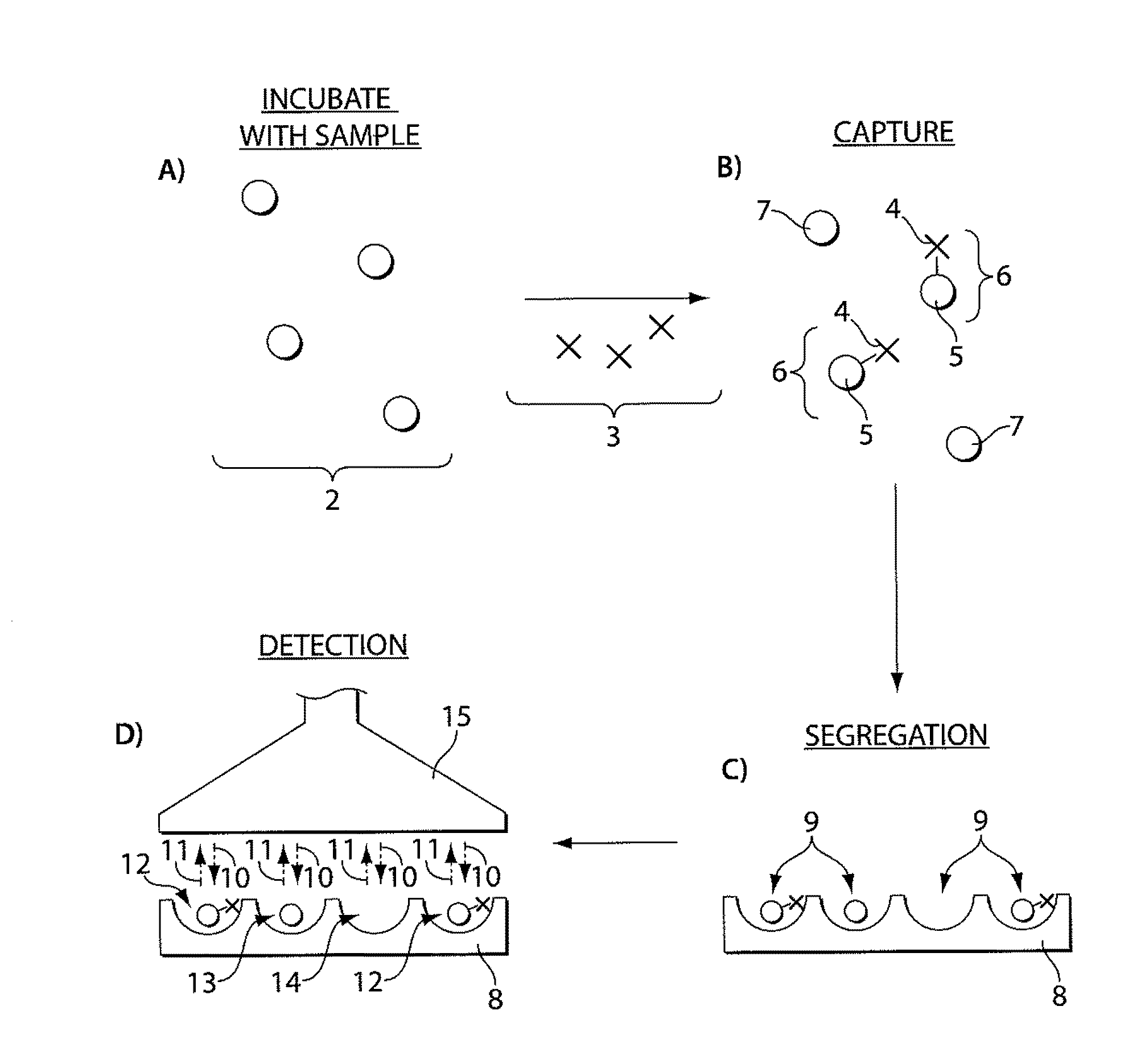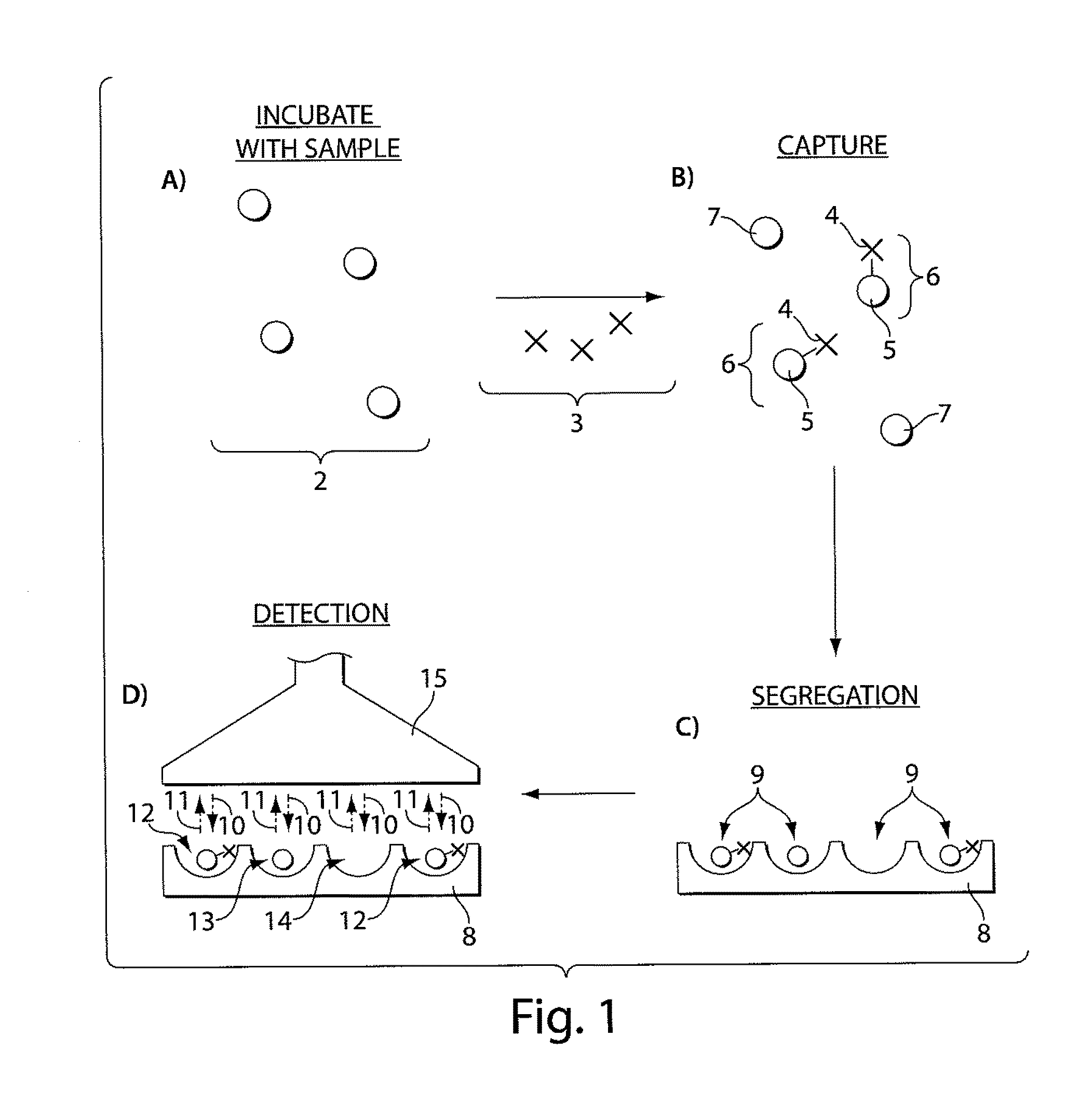Ultra-sensitive detection of molecules or particles using beads or other capture objects
a technology of capture objects and molecules, applied in the field of ultra-sensitive detection of molecules or particles in fluid samples, can solve the problems of limiting the sensitivity of most detection techniques and the dynamic range, false positive signal generation, and many known methods and techniques are further plagued by problems of non-specific binding
- Summary
- Abstract
- Description
- Claims
- Application Information
AI Technical Summary
Benefits of technology
Problems solved by technology
Method used
Image
Examples
example 1
[0224]This following example describes materials used in Examples 2-19. Optical fiber bundles were purchased from Schott North America (Southbridge, Mass.). Non-reinforced gloss silicone sheeting was obtained from Specialty Manufacturing (Saginaw, Mich.). Hydrochloric acid, anhydrous ethanol, and molecular biology grade Tween-20 were purchased from Sigma-Aldrich (Saint Louis, Mo.). 2.8-um (micrometer)-diameter tosyl-activated magnetic beads were purchased from Invitrogen (Carlsbad, Calif.). 2.7-um-diameter carboxy-terminated magnetic beads were purchased from Varian, Inc. (Lake Forest, Calif.). Monoclonal anti-human TNF-αcapture antibody, polyclonal anti-human TNF-α detection antibody, and recombinant human TNF-α were purchased from R&D systems (Minneapolis, Minn.). Monoclonal anti-PSA capture antibody and monoclonal detection antibody were purchased from BiosPacific (Emeryville, Calif.); the detection antibody was biotinylated using standard methods. 1-ethyl-3-(3-dimethylaminopropy...
example 2
[0225]The following describes a non-limiting example of the preparation of 2.8-um-diameter magnetic beads functionalized with protein capture antibody. 600 uL (microliter) of 2.8-um-diameter tosyl-activated magnetic bead stock (1.2×109 beads) was washed three times in 0.1 M sodium borate coating buffer pH 9.5. 1000 ug (microgram) of capture antibody was dissolved in 600 uL of sodium borate coating buffer. 300 uL of 3M ammonium sulfate was added to the antibody solution. The 600 uL of bead solution was pelleted using a magnetic separator and the supernatant was removed. The antibody solution was added to the beads and the solution was allowed to mix at 37° C. for 24 hours. After incubation, the supernatant was removed and 1000 uL of PBS buffer containing 0.5% bovine serum and 0.05% Tween-20 was added to the beads. The beads were blocked overnight (˜8 hours) at 37° C. The functionalized and blocked beads were washed three times with 1 ml PBS buffer containing 0.1% bovine serum and 0.0...
example 3
[0226]The following describes a non-limiting example of the preparation of 2.7-um-diameter magnetic beads functionalized with protein capture antibody. 500 uL of 2.7-um-diameter carboxy-terminated magnetic beads stock (1.15×109 beads) was washed twice in 0.01 M sodium hydroxide, followed by three washes in deionized water. Following the final wash, the bead solution was pelleted and the wash solution was removed. 500 uL of a freshly prepared 50 mg / mL solution of NHS in 25 mM MES, pH 6.0, was added to the bead pellet and mixed. Immediately, a 500 uL of a freshly prepared 50 mg / mL solution of EDC in 25 mM MES, pH 6.0, was added to the bead solution and mixed. The solution was then allowed to mix for 30 min at room temperature. After activation, the beads were washed twice with 25 mM MES at pH 5.0. Meanwhile, 1000 uL of 25 mM MES at pH 5.0 was used to dissolve 1000 ug of capture antibody. The antibody solution was then added to the activated beads and the coupling reaction was allowed ...
PUM
| Property | Measurement | Unit |
|---|---|---|
| diameter | aaaaa | aaaaa |
| diameter | aaaaa | aaaaa |
| concentration | aaaaa | aaaaa |
Abstract
Description
Claims
Application Information
 Login to View More
Login to View More - R&D
- Intellectual Property
- Life Sciences
- Materials
- Tech Scout
- Unparalleled Data Quality
- Higher Quality Content
- 60% Fewer Hallucinations
Browse by: Latest US Patents, China's latest patents, Technical Efficacy Thesaurus, Application Domain, Technology Topic, Popular Technical Reports.
© 2025 PatSnap. All rights reserved.Legal|Privacy policy|Modern Slavery Act Transparency Statement|Sitemap|About US| Contact US: help@patsnap.com



